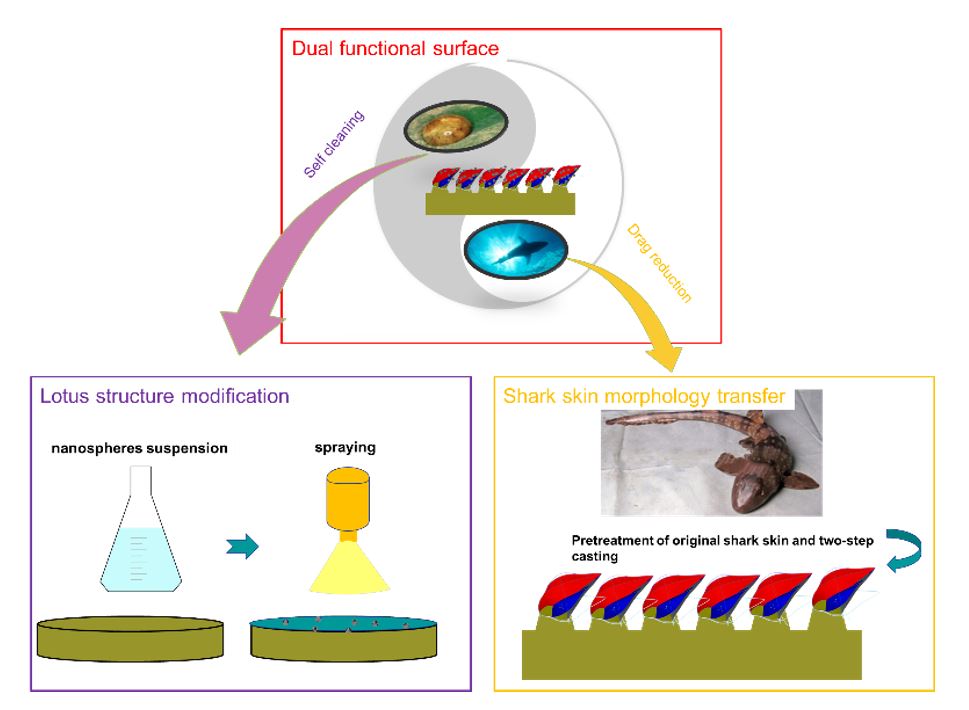Video Article Open Access
Dual-Function Surface for Efficient Drag Reduction and Potential Antifouling Capabilities
Liguo Qin1,*, Guangneng Dong1, Yali Zhang2
1Key Laboratory of Education Ministry for Modern design & Rotary-Bearing system, Xi’an Jiaotong University, Xianning West Road, Xi’an 710049, China
2Key Laboratory of Biomedical Information Engineering of Ministry of Education, Xi’an Jiaotong University, Xianning West Road, Xi’an 710049, China
Vid. Proc. Adv. Mater., Volume 2, Article ID 2021-0158 (2021)
DOI: 10.5185/vpoam.2021.0158
Publication Date (Web): 09 Feb 2021
Copyright © IAAM
Graphical Abstract

Abstract
To improve the drag-reducing and antifouling performance of marine equipment, it is indispensable to learn from structures and materials that are found in nature. This is due to their excellent properties, such as intelligence, microminiaturization, hierarchical assembly, and adaptability. Considerable interest has arisen in fabricating surfaces with various types of biomimetic structures, which exhibit promising and synergistic performances similar to living organisms. In this study, a dual bio-inspired shark-skin and lotus-structure (BSLS) surface was developed for fabrication on commercial polyurethane (PU) polymer. Firstly, the shark-skin pattern was transferred on the PU by microcasting. Secondly, hierarchical micro- and nanostructures were introduced by spraying mesoporous silica nanospheres (MSNs). The dual biomimetic substrates were characterized by scanning electron microscopy, water contact angle characterization, antifouling, self-cleaning, and water flow impacting experiments. The results revealed that the BSLS surface exhibited dual biomimetic features. The micro- and nano-lotus-like structures were localized on a replicated shark dermal denticle. A contact angle of 147° was observed on the dual-treated surface and the contact angle hysteresis was decreased by 20% compared with that of the nontreated surface. Fluid drag was determined with shear stress measurements and a drag reduction of 36.7% was found for the biomimetic surface. With continuous impacting of high-speed water for up to 10 h, the biomimetic surface stayed superhydrophobic. Material properties such as inhibition of protein adsorption, mechanical robustness, and self-cleaning performances were evaluated, and the data indicated these behaviors were significantly improved. The mechanisms of drag reduction and self-cleaning are discussed. Our results indicate that this method is a potential strategy for efficient drag reduction and antifouling capabilities.
Keywords
Shark skin, lotus-like structure, drag reduce, antifouling, hydrophobicity.
Acknowledgement
This work was supported by the Fundamental Research Funds for the Central Universities. The authors acknowledge the joint financial support from the National Key R&D Program of China (2018YFB1306100), National Natural Science Foundation of China (51975458) and the Natural Science Fund of Shaanxi Province (2017JQ5009).
References
- L. Qin*, M Hafezi, H Yang, G Dong, Y Zhang. Micromachines, 2019, 10(7), 490.
Biography
Currently Liguo Qin holds positions both of Postdoc researcher in KTH and Associate professor in Xi'an Jiaotong university. His research work is on how to control the tribological performance of engineering surface and how the surface interacts with lubricants. The aim is to solve problems and generate greater understanding relevant to a range of applications including Bio-tribology, Drag reduction & Multifunctional surface construction. Currently he has published papers over 30, such as Applied surface science, Tribology International and Carbohydrate polymers. He has obtained the University excellent doctoral thesis and shaanxi province excellent doctoral thesis (2018). He was invited over 10 times' speaking. During European Advanced Materials Congress of 2018, he was selected as IAAM scientist Medal. As Principal Investigator, he has hosted 10 projects including National Natural Science Foundation of China, Natural Science Fund of Shaanxi Province and China Postdoctoral Science Foundation funded project.
Video Proceedings of Advanced Materials

Upcoming Congress



